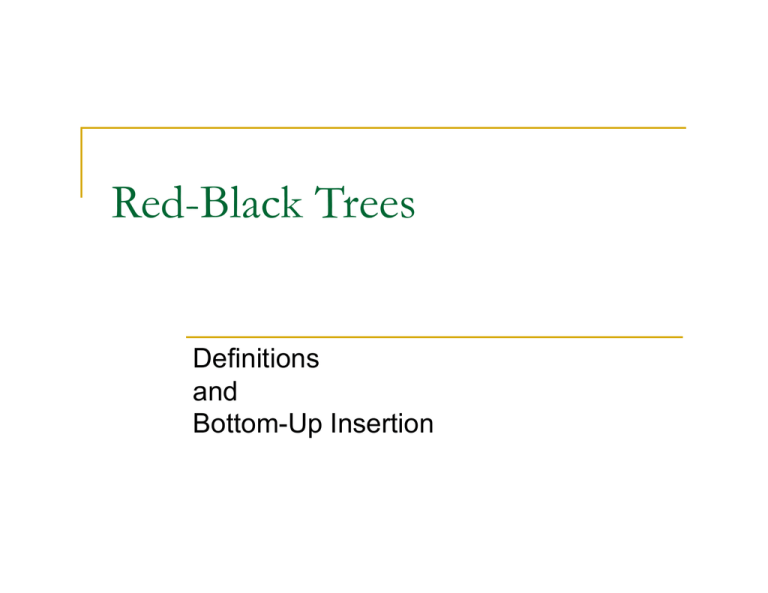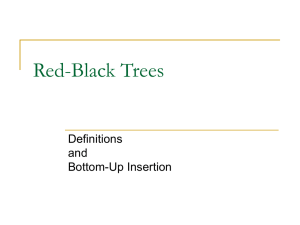Red-Black Trees
advertisement

Red-Black Trees Definitions and Bottom-Up Insertion Red-Black Trees Definition: A red-black tree is a binary search tree in which: Every node is colored either Red or Black. Each NULL pointer is considered to be a Black “node”. If a node is red, its two children must be black. Every path from a node to a NULL contains the same number of Black nodes. By convention, the root is Black Definition: The black-height of a node, X, in a red-black tree is the number of Black nodes on any path to a NULL, not counting X. UMBC CSMC 341 Red-Black-Trees-1 2 X A Red-Black Tree with NULLs shown Black-Height of the tree (the root) = 3 Black-Height of node “X” = 2 UMBC CSMC 341 Red-Black-Trees-1 3 A Red-Black Tree with Black-Height = 3 UMBC CSMC 341 Red-Black-Trees-1 4 X Black Height of the tree? Black Height of X? UMBC CSMC 341 Red-Black-Trees-1 5 Bottom –Up Insertion Insert node as usual in BST Color the node Red What Red-Black property may be violated? Every node is Red or Black? NULLs are Black? If node is Red, both children must be Black? Every path from node to descendant NULL must contain the same number of Blacks? UMBC CSMC 341 Red-Black-Trees-1 6 Bottom Up Insertion Insert node; Color it Red X is pointer to it to be added to the tree Cases 0: X is the root -- color it Black 1: Both parent and uncle are Red -- color parent and uncle Black, color grandparent Red. Point X to grandparent and check new situation. 2 (zig-zag): Parent is Red, but uncle is Black. X and its parent are opposite type children -- color grandparent Red, color X Black, rotate left(right) on parent, rotate right(left) on grandparent 3 (zig-zig): Parent is Red, but uncle is Black. X and its parent are both left (right) children -- color parent Black, color grandparent Red, rotate right(left) on grandparent 8/3/2007 UMBC CSMC 341 Red-Black-Trees-1 7 G P X U G X P U Case 1 – U is Red Just Recolor and move up UMBC CSMC 341 Red-Black-Trees-1 8 G P U X S X P Case 2 – Zig-Zag Double Rotate X around P; X around G G S U Recolor G and X UMBC CSMC 341 Red-Black-Trees-1 9 G P X U S P X G Case 3 – Zig-Zig Single Rotate P around G S Recolor P and G UMBC CSMC 341 Red-Black-Trees-1 U 10 Asymptotic Cost of Insertion O(lg n) to descend to insertion point O(1) to do insertion O(lg n) to ascend and readjust == worst case only for case 1 Total: O(log n) UMBC CSMC 341 Red-Black-Trees-1 11 11 Insert 4 into this R-B Tree 14 2 1 7 5 Black node 15 8 Red node UMBC CSMC 341 Red-Black-Trees-1 12 Insertion Practice Insert the values 2, 1, 4, 5, 9, 3, 6, 7 into an initially empty Red-Black Tree UMBC CSMC 341 Red-Black-Trees-1 13 Top-Down Insertion An alternative to this “bottom-up” insertion is “top-down” insertion. Top-down is iterative. It moves down the tree, “fixing” things as it goes. What is the objective of top-down’s “fixes”? UMBC CSMC 341 Red-Black-Trees-1 14 Theorem 1 – Any red-black tree with root x, has n ≥ 2bh(x) – 1 nodes, where bh(x) is the black height of node x. Proof: by induction on height of x. UMBC CSMC 341 Red-Black-Trees-1 15 Theorem 2 – In a red-black tree, at least half the nodes on any path from the root to a NULL must be Black. Proof – If there is a Red node on the path, there must be a corresponding Black node. Algebraically this theorem means bh( x ) ≥ h/2 UMBC CSMC 341 Red-Black-Trees-1 16 Theorem 3 – In a red-black tree, no path from any node, X, to a NULL is more than twice as long as any other path from X to any other NULL. Proof: By definition, every path from a node to any NULL contains the same number of Black nodes. By Theorem 2, a least ½ the nodes on any such path are Black. Therefore, there can no more than twice as many nodes on any path from X to a NULL as on any other path. Therefore the length of every path is no more than twice as long as any other path. UMBC CSMC 341 Red-Black-Trees-1 17 Theorem 4 – A red-black tree with n nodes has height h ≤ 2 lg(n + 1). Proof: Let h be the height of the red-black tree with root x. By Theorem 2, bh(x) ≥ h/2 From Theorem 1, n ≥ 2bh(x) - 1 Therefore n ≥ 2 h/2 – 1 n + 1 ≥ 2h/2 lg(n + 1) ≥ h/2 2lg(n + 1) ≥ h UMBC CSMC 341 Red-Black-Trees-1 18


